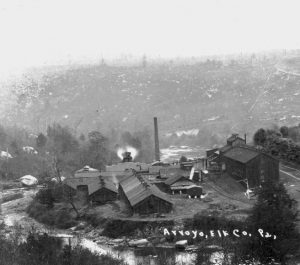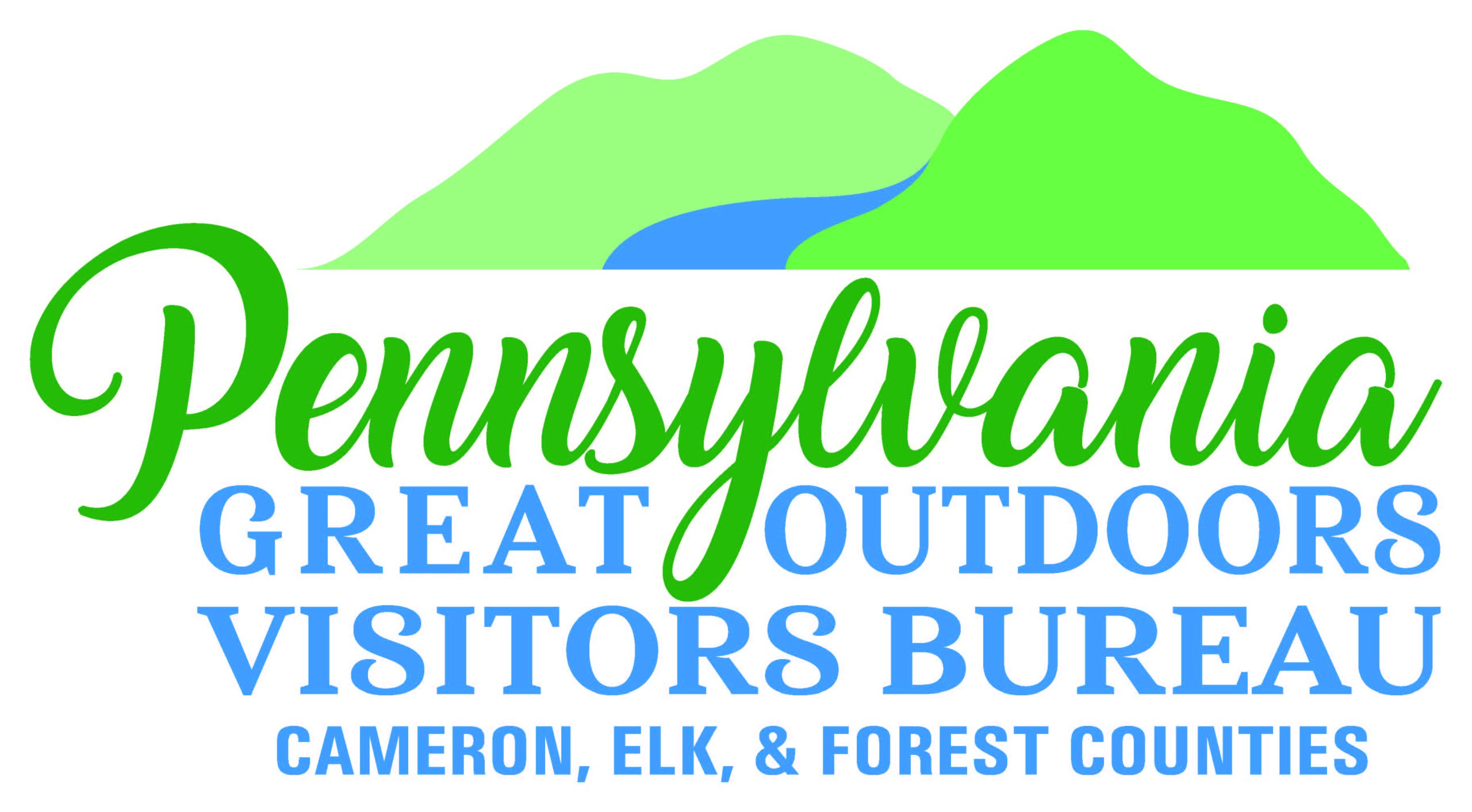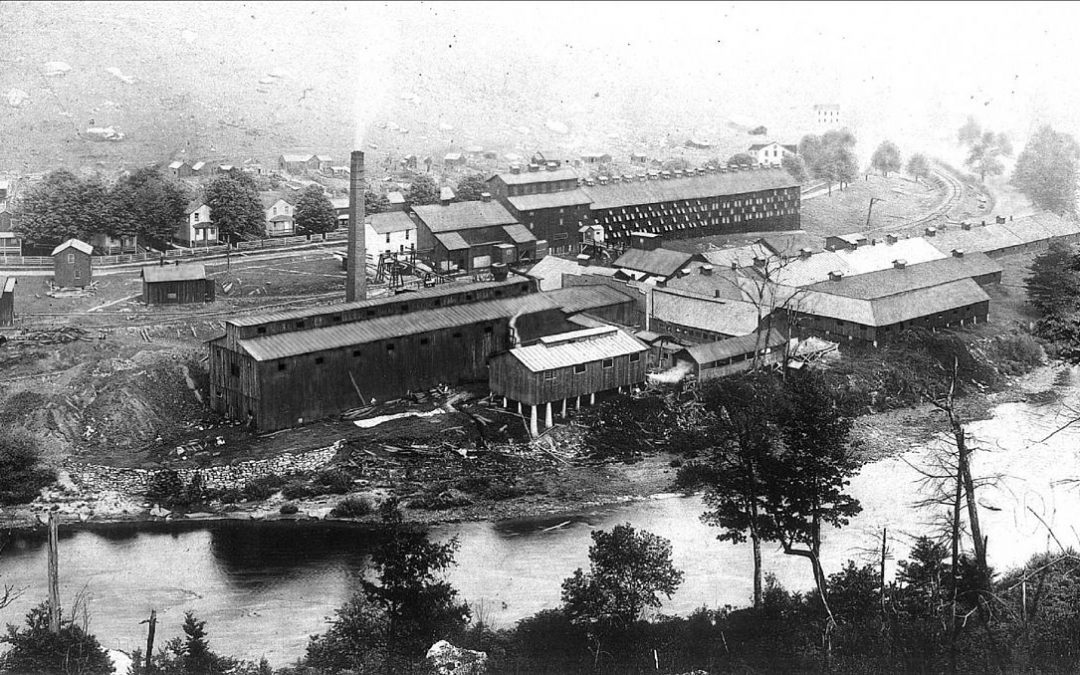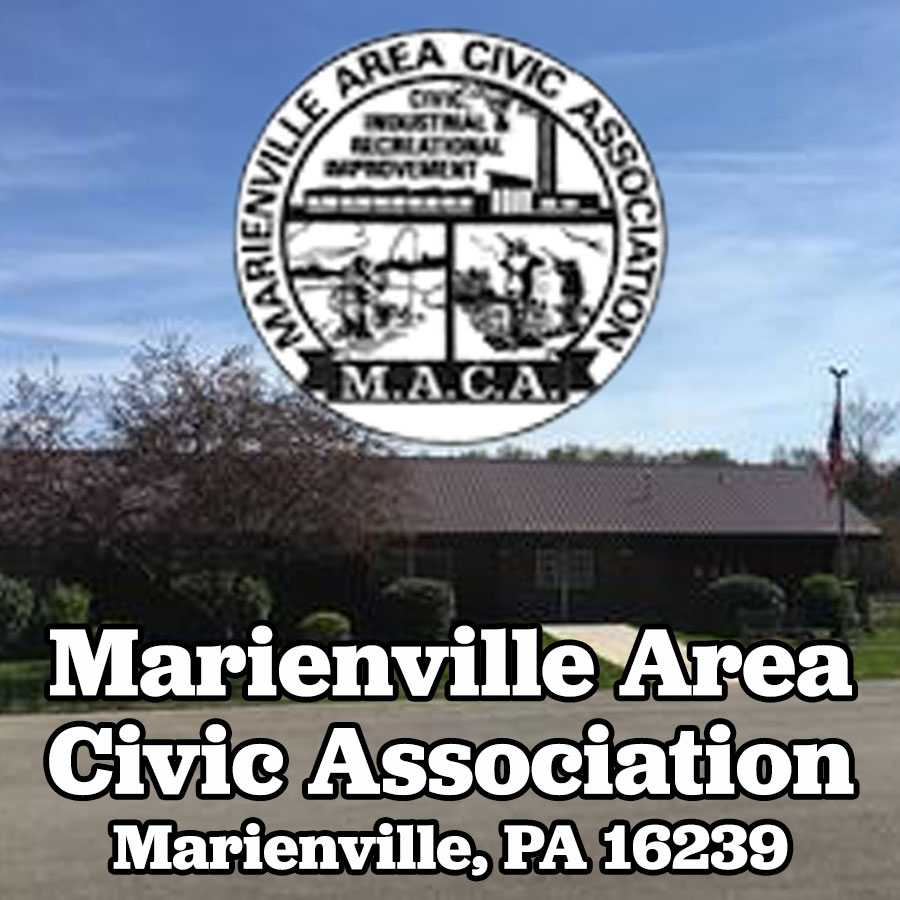Written by: John Imhof
This history is the eighth in a series of articles drawn from the writings of John Imhof in his book Elk County: A Journey through Time published in 2003 describing the ghost towns that once existed along the Clarion River from Ridgway to Hallton and adjacent to Ridgway. Mr. Imhof’s book is very popular and the first printing was sold out but is available again through Amazon.com. Arroyo – 1830’s to 1930’s *Arroyo was originally named Beech Bottom prior to the Great 1861 Flood that scoured the Clarion River Valley from one end to the other all the way to Parker and its junction with the Allegheny River. The name Arroyo became a tongue-in-cheek reference after the flood since Arroyo translates to roughly “Dry River Bed” in Spanish. Arroyo began its roughly one hundred-year life-span as the town of Beech Bottom. The town first sprang to life under the guidance of Elk County lumberman Thomas Irwin, who built a small mill somewhere upstream of the current bridge over the Clarion River. Very little is known of the earliest days of Beech Bottom. Aside from the Irwin mill and a shingle mill, another sawmill under the ownership of Mr. C. C. Rogers was constructed near the current bridge, possibly on a flat section of land on an island near the northwest bank of the Clarion. Sometime in the 1840s, Blake and Company began work at Beech Bottom. This work included the construction of a large dam across the Clarion River and a mill race along the western bank. This mill race created an island that was remembered as being four to five acres in size. It is believed that this mill race drained into a natural side channel just above the present-day Arroyo bridge. In any case, clear evidence of this mill race remains along the banks of the river, nearly 160 years after it was first constructed. Again, little is known about the Blake and Company operation, but it seems likely that this firm was associated in some way with Thomas Irwin. This conclusion comes from the fact that Thomas Irwin departed Beech Bottom in 1851, the same year that a major project was undertaken to upgrade the Beech Bottom mill. Irwin would move several miles downstream and establish a new town, while a state-of-the-art mill was located upstream from the C. C. Rogers operation. This new mill would become the largest industry in the early years of Beech Bottom and two men would be the key players. Ruloff Ruloffson came from Novia Scotia and had been actively involved in lumbering for many years. Through contacts made in Maine he obtained a contract with several Eastern capitalists to log their holdings along the Clarion River. Since the bulk of the owners came from near Portland, Maine, the new venture was called the Portland Company. Whether Blake and Company was absorbed by the Portland Company or was simply an earlier name for the same firm is not certain. What is certain is that Ruloffson set about to build the best mill yet seen in Elk County that would be known as the Crescent Mill. The mill machinery would be of the highest quality and include a circular saw capable of producing an amazing 40,000 board feet of lumber in a single day. While this production would seem small by later standards, it was a gigantic step up from the several thousand board feet that could be produced by the older sash mills. The major problem for Ruloffson was, how to get the huge machinery into an area with few roads. Not to be stopped by such a detail, Ruloffson contracted to have the machinery built in New Jersey. He then arranged to have the load floated across the state via the Pennsylvania Mainline Canal. When the machinery finally reached Freeport, on the Allegheny River, it was loaded on barges and poled to the Clarion River. From that point, a combination of river and wagon travel finally succeeded in reaching Beech Bottom. Once the mill was established, Ruloffson contracted for the services of John Cobb. Cobb brought along his sons, Roll and Barrett, and the team set about turning the mill into a money maker. For the next several years, the group prospered, shipping millions of feet of lumber to markets in Pittsburgh and points down river. Since no railroad or substantial roads existed, this shipment was accomplished by rafting the lumber down the Clarion. In 1858, Ruloffson departed Beech Bottom and built his own empire down river at Mill Creek, not far from Clarion. Cobb remained behind and was to pay a high price for his decision. The year 1861 would prove to be the end of the original town of Beech Bottom. In September of that year a massive flood swept the Clarion valley, literally scouring away everything in its path from the steep banks of the river. Unfortunately for John Cobb, he and his mill were very much in t he path. As the waters rose with frightening rapidity, Cobb was forced to take to a Johnny boat and hang on to the peak of his two-story home. In a moment of desperation, the famously profane Cobb called out to the Almighty and is reputed to have said, “Lord, I’ve never asked you for anything before and if you get me out of this, I’ll never ask you for another thing.” Based on field observations done by Bob and John Imhof and identifying the site of Mr. Cobb’s home on the flat above the Crescent Mill, mill dam and the normal pool level of the Clarion River, the flood coming down the valley was somewhere between forty and fifty feet high. Given that almost everything related to the lumbering industry at that time was built near the river, the destruction was incredible. Cobb’s life was spared, but his mill was swept away, along with the bulk of the homes and other building in Beech Bottom. For several years, the community slumbered. It seems that the Rogers mill was either spared or quickly rebuilt. Cobb moved on and the site of his mill was abandoned. No major new development occurred at Beech Bottom until the late 1870s when rumors began to be heard about plans for a tannery. In 1880, these rumors became reality as work was begun on the Smith, Rogers and Company Tannery. This tannery would define the character of the town that was soon renamed Arroyo. The tannery was a huge operation with over a dozen buildings. It was built on an area of relatively flat ground below the Arroyo bridge. For the first decade of its existence, the tannery would have been forced to team its output to market, since the nearest railroad connections would have been near Portland Mills or Ridgway. It is not known if the river was ever used to ship goods from the tannery, but this does seem to be a possibility. With the construction of the tannery, Arroyo developed quickly into a complete town of the time. Included in the town were at least 40 homes, two stores, a school, church, post office, several boarding houses, one of which contained a stage for theatrical performances, a water supply system and natural gas for the homes. The Atlas of Pennsylvania for 1895 lists Arroyo as having a population of 122. This figure seems low based on the number of structures and may not have included children. In all likelihood, the peak population of Arroyo was probably in the range of 250. After the construction of the tannery, Horton, Hinkle and Company constructed a sawmill along Crow Run and opened a large store. While the sawmill seems to have been a short-lived affair, the store would prosper for many years, and was eventually purchased by Smith Brothers in 1898. Another store, owned by Otto Buehler, was located on the opposite end of town near the school and Methodist Church. Also located near Arroyo in this time period was the sawmill of Bodine and Warn. Almost nothing is known of this mill, and even its precise location is the subject of some confusion. It seems likely that it may have been located at the site of the old Cobb and Ruloffson Crescent mill, but this has yet to be confirmed.
he path. As the waters rose with frightening rapidity, Cobb was forced to take to a Johnny boat and hang on to the peak of his two-story home. In a moment of desperation, the famously profane Cobb called out to the Almighty and is reputed to have said, “Lord, I’ve never asked you for anything before and if you get me out of this, I’ll never ask you for another thing.” Based on field observations done by Bob and John Imhof and identifying the site of Mr. Cobb’s home on the flat above the Crescent Mill, mill dam and the normal pool level of the Clarion River, the flood coming down the valley was somewhere between forty and fifty feet high. Given that almost everything related to the lumbering industry at that time was built near the river, the destruction was incredible. Cobb’s life was spared, but his mill was swept away, along with the bulk of the homes and other building in Beech Bottom. For several years, the community slumbered. It seems that the Rogers mill was either spared or quickly rebuilt. Cobb moved on and the site of his mill was abandoned. No major new development occurred at Beech Bottom until the late 1870s when rumors began to be heard about plans for a tannery. In 1880, these rumors became reality as work was begun on the Smith, Rogers and Company Tannery. This tannery would define the character of the town that was soon renamed Arroyo. The tannery was a huge operation with over a dozen buildings. It was built on an area of relatively flat ground below the Arroyo bridge. For the first decade of its existence, the tannery would have been forced to team its output to market, since the nearest railroad connections would have been near Portland Mills or Ridgway. It is not known if the river was ever used to ship goods from the tannery, but this does seem to be a possibility. With the construction of the tannery, Arroyo developed quickly into a complete town of the time. Included in the town were at least 40 homes, two stores, a school, church, post office, several boarding houses, one of which contained a stage for theatrical performances, a water supply system and natural gas for the homes. The Atlas of Pennsylvania for 1895 lists Arroyo as having a population of 122. This figure seems low based on the number of structures and may not have included children. In all likelihood, the peak population of Arroyo was probably in the range of 250. After the construction of the tannery, Horton, Hinkle and Company constructed a sawmill along Crow Run and opened a large store. While the sawmill seems to have been a short-lived affair, the store would prosper for many years, and was eventually purchased by Smith Brothers in 1898. Another store, owned by Otto Buehler, was located on the opposite end of town near the school and Methodist Church. Also located near Arroyo in this time period was the sawmill of Bodine and Warn. Almost nothing is known of this mill, and even its precise location is the subject of some confusion. It seems likely that it may have been located at the site of the old Cobb and Ruloffson Crescent mill, but this has yet to be confirmed.
The bridge that currently (2002) crosses the Clarion was built in 1901 to replace an earlier structure that may have been destroyed in flooding. It was also built to provide free crossing for the people of Spring Creek Township, since the earlier bridge had been a toll facility. Precisely where the original bridge was built and what form it took also remains a subject of some conjecture. One old map shows a bridge crossing the island above the current bridge and it is known that this course was later used for a tramway to a sand quarry. If this location is valid, it is also possible that a dam may have been built across both channels of the river. This would have served to eliminate some ripples in the river and would also have made the construction of a bridge easier. Some evidence can also be found on the opposite bank of the Clarion, but this takes the form of a road that seems to lead to a ford, rather than a bridge abutment. It is possible that any evidence of the abutment has long since been swept away by the numerous floods along the river. Arroyo’s peak prosperity began in 1891 when the Clarion River Railway reached the town. With a direct connection to both the Buffalo, Rochester and Pittsburgh Railroad at Carman and the Ridgway and Clearfield branch of the Pennsylvania Railroad at Croyland, the new line provided an easy route for finished goods, supplies and passengers. Arroyo continued at this pace for several decades. The tannery was purchased by the giant United States Leather Company and named the North Star facility. Hundreds found employment in the tannery and related occupations in the woods, such as obtaining the hemlock bark that was used to create tannic acid. By the 1920s, conditions within the tanning industry were changing rapidly. Most of the hills in central Pennsylvania had been denuded of all hemlock, eliminating the primary source for tannic acid. The tanneries that survived were forced to find alternative sources. Further, the need for harness leather had been on the decline for several decades, and direct drive machinery had eliminated the need for the massive leather belts that had once transferred power. These factors, coupled with an increased concern for the pollution created by tanneries prompted the closing of many smaller operation in the early 1900s. Arroyo held on until at least 1924. At this time the Elk Tanning Company, a division of the United States Leather Company, reduced its stock to one-third of its 1893 value. One of the provisions of this reduction involved the closing of the Arroyo tannery. The end probably came in early 1925. With the closing of the tannery Arroyo began a rapid decline. By the 1930s, most of the homes had been torn down and the tannery had been salvaged. All that remained was the bridge and a variety of ruins. One resident, Mr. John Simon, recalled to John Imhof helping his father salvage several of the old outbuildings, and playing in the former finishing building, much of which was built of cypress. Today, Mr. Simon’s home occupies the site of the last original home left standing at Arroyo. The home had belonged to the Laughner family and burned in an unfortunate fire in the early 1980s. Arroyo remains today as the most complete ghost town in Elk County. Virtually every structure can be identified, and remains of human activity litter the ground, though anything of value has long since been removed. Most of the town site is now part of the Allegheny National Forest.

















